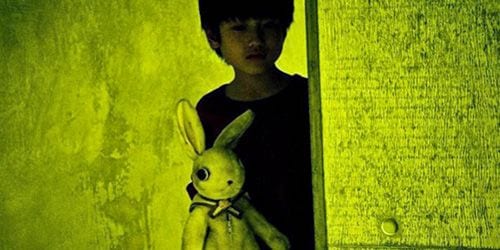
A stuffed bunny that comes to life, an amusement park carousel, and a family struggling with the death of a mother: it’s a recipe for a heart-warming Easter story… or another disturbing film from Takashi Shimizu, director of The Grudge. A tale of trauma and sacrifice, Tormented blends psychological realism and supernatural horror to create an inventive, disorienting world where delusion, nightmare, and reality blend. The film also provides a critical view of traditional family dramas, highlighting especially the limitations of roles for girls.
Kiriko (Hikari Mitsushima) and her little brother Daigo (Takeru Shibuya) are misfits at the school where he’s a student and she is a librarian. The other kids think that Daigo killed a rabbit in cold blood when, according to his sister, he was putting the wounded animal out of its misery. Kiriko has been mute since the death of her stepmother, Daigo’s biological mother. At home their widower father (Nao Omori) ignores them in favor of the elaborate illustrated pop-up books that he creates.
When Kiriko and Daigo go to a 3D film, the boy takes home a stuffed rabbit that miraculously emerges from the screen. Soon both siblings are visiting an alternate space where the rabbit comes to life and scenes from the past first soothe, then threaten. When the father finally notices what’s going on, he engages doctors, who diagnose Kiriko as delusional. The true state of affairs proves much more complicated than that.
Both father and daughter are obsessed with the Hans Christian Andersen fairy tale “The Little Mermaid”, a story about a young mermaid who falls in love with a human prince. In the hope that the prince will fall in love with her, making her fully human and granting her an immortal soul, she gives her voice to a sea witch in exchange for legs. After her hopes are dashed when the prince marries another woman, the mermaid’s only option to escape death is to kill the prince, which will enable her to return to her mermaid form. In Andersen’s ending, the mermaid gains a reprieve of sorts. As a spirit she has the chance to earn a soul by doing good works. In the 1989 Disney animated adaptation, of course, the little mermaid marries the prince and they live happily ever after.
That’s not Shimizu’s way. Tormented focuses instead on the limited choices offered Andersen’s heroine—between transformative violence and self-sacrifice—and the fairy tale’s sadistic twist that while the mermaid’s legs enable her to dance, she suffers excruciating pain while doing so. Broken glass and cutting recur in the film.
While the father faithfully represents Andersen’s fairy tale in his artwork, Kiriko works towards an alternate plot. She narrates parts of Tormented, and has the ability to speak in the delusional world. The film eventually becomes a struggle between father and daughter over who will control their family drama, particularly whether son or daughter will gain primacy.
While “The Little Mermaid” plot in part structures the narrative of Tormented, a primal mini-plot recurs, slightly different each time, sometimes rendered realistically, sometimes in grainy saturated color granting it the status of a memory or dream. In one view, Daigo kills the rabbit while Kiriko watches. In another, a young Kiriko rides a carousel with her stepmother, who is dressed in a rabbit suit and who gives Kiriko a stuffed rabbit. Together the rabbit scenes make up a rich complex contrasting male and female agency, childbirth and the genesis of delusion, trauma and catharsis. Shimizu masterfully brings both mermaid and rabbit narrative strands together at the climax of the film. You’ll never look at rabbits, or mermaids, in the same way.
The 3D format couldn’t be more appropriate to Tormented. Contemporary Japanese horror cinema often turns on technology as a medium that allows communication between the supernatural and natural worlds. A ghost emerges from a television screen in The Ring, while victims receive spectral cell phone messages prefiguring their deaths in One Missed Call, for example. In Tormented, it’s the 3D film the brother and sister watch that first causes the supernatural to erupt into their lives.
The format also has thematic resonance. From the flying bunny to the beautiful paper renderings that pop up from the pages of the father’s books, to pivotal scenes shot along the axis of a spiral staircase, 3D reinforces the premise that reality is thick, layered, full of depth.
The Blu-ray edition of Tormented comes with 3D and 2D versions. The 3D version looks great, with the exception of some ghosting in medium close-ups against a dark background.

![Call for Papers: All Things Reconsidered [MUSIC] May-August 2024](https://www.popmatters.com/wp-content/uploads/2024/04/all-things-reconsidered-call-music-may-2024-720x380.jpg)



